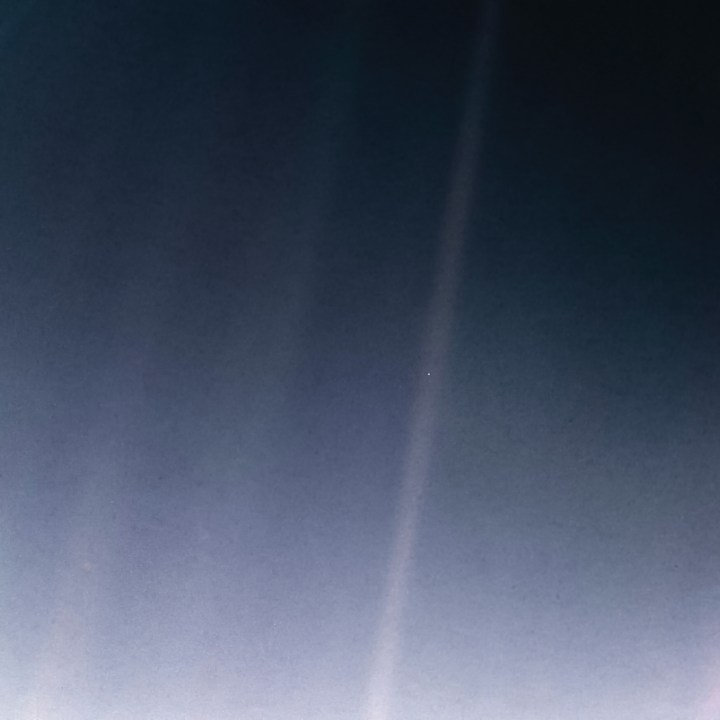
We’re living through a golden age of space exploration, from rovers landing on Mars to astronauts living on board the International Space Station to the most complex and capable telescopes ever devised sending back stunning images of the cosmos. With technology like the high definition cameras on the Perseverance rover and the incredible sensitive infrared detectors on the James Webb Space Telescope, we’re getting new views of the world beyond our own planet every day.
Some images of space stay entrenched in the public imagination, like the famous Pale blue Dot photos from 1990. It shows Earth as seen by the Voyager spacecraft just minutes before its camera was turned off. Traveling beyond the orbit of Pluto, the image shows the view when Voyager turned back around and viewed Earth — the tiny, almost imperceptible dot seen against the emptiness of space.
It famously inspired the legendary astronomer Carl Sagan, who described it in his book Pale Blue Dot: A Vision of the Human Future in Space:
“Consider again that dot. That’s here. That’s home. That’s us. On it everyone you love, everyone you know, everyone you ever heard of, every human being who ever was, lived out their lives. The aggregate of our joy and suffering, thousands of confident religions, ideologies, and economic doctrines, every hunter and forager, every hero and coward, every creator and destroyer of civilization, every king and peasant, every young couple in love, every mother and father, hopeful child, inventor and explorer, every teacher of morals, every corrupt politician, every “superstar,” every “supreme leader,” every saint and sinner in the history of our species lived there – on a mote of dust suspended in a sunbeam.”
The version of the image shown above is a reprocessed version released by NASA in 2020, using modern processing techniques on the same data to celebrate the 30th anniversary of this remarkable image.
To carry on the cosmic journey, we’ve put together 60 of the most stunning images of space.
Cosmic cliffs
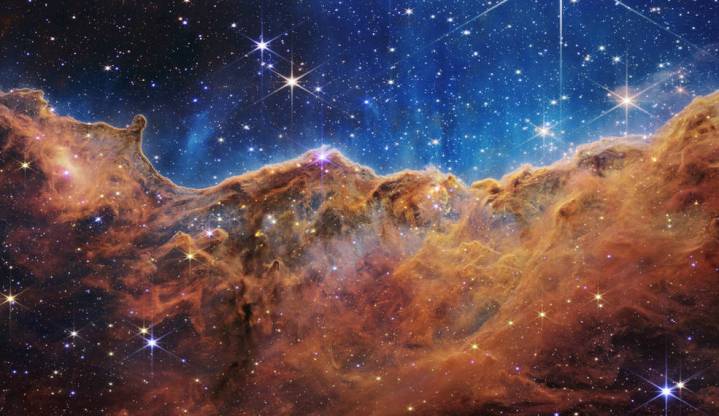
When the James Webb Space Telescope launched in December 2021, the world waited with baited breath to see what images of the cosmos this brand-new tool would be able to deliver. And they found out in July 2022 when, after several months of the telescope unfolding into its final configuration and performing checks and calibrations of its instruments, the first full images from the telescope were released.
This stunning image was one of those first images, and has become iconic of the Webb telescope and all its achievements. The image shows a portion of the Carina Nebula which has been nicknamed the Cosmic Cliffs, as the dramatic shape of the dust formations against the background of the sky looks like a beautiful cliff formation.
The heart of the Milky Way
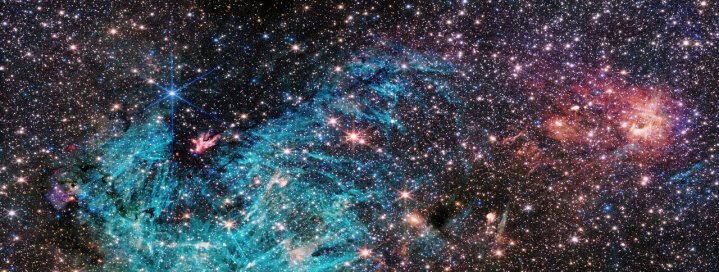
This stunning image, taken by the James Webb Space Telescope’s NIRCam instrument, shows a reigon near the center of our galaxy, the Milky Way. At the center of our galaxy, like most other galaxies, there is a supermassive black hole called Sagittarius A*. This image shows the nearby Sagittarius C region, with 500,000 stars shining through the view. The region is full of ionised hydrogen, which appears in cyan, and is busy with hot, young stars. The different colors in the image show different processes, colored due to Webb looking in the infrared portion of the electromagnetic spectrum.
The famous Crab Nebula
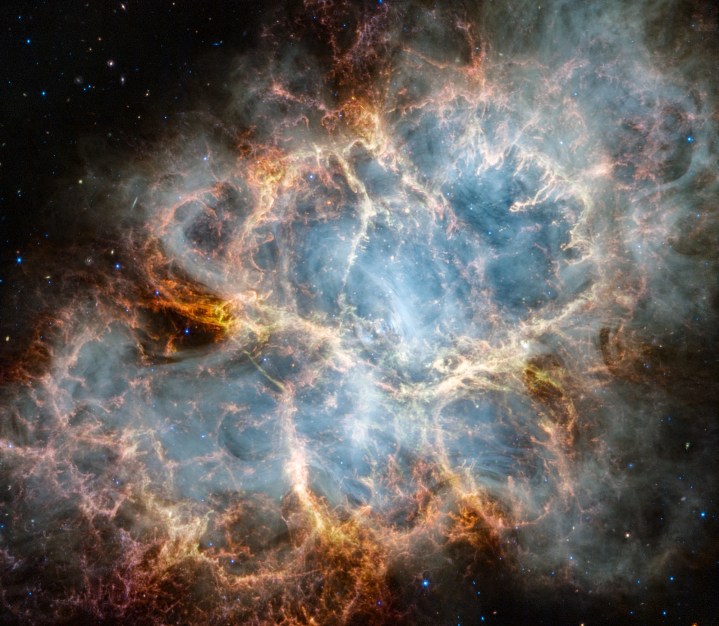
When a massive star reaches the end of its life and explodes in an event called a supernova, it can leave behind a remnant which persists for thousands of year. That was what created the famous Crab Nebula, a complex structure of filaments of dust which form a cage-like shape around the dense core that is all that remains of the once bright star. The supernova which created this remnant was first observed on Earth in 1054, and the object it left behind has been observed by many telescopes since then. This particular image is from the James Webb Space Telescope, using data from both its NIRCam (Near-Infrared Camera) and MIRI (Mid-Infrared Instrument) instruments.
A Christmas galaxy cluster

Telescopes like the James Webb Space Telescope don’t only work on their own. Sometimes, scientists will combine data from multiple telescopes to get a more detailed view of a complex object. This image, for example, includes data from both James Webb and the Hubble Space Telescope. Webb’s instruments operate in the infrared portion of the spectrum, while Hubble’s operate primarily in the visible light portion of the spectrum (the same part that is visible to the human eye). By combining these two views of a single object, in this case a galaxy cluster called MACS0416, scientists can see features that would be invisible if they looked in just one wavelength.
This cluster is also known as the Christmas Tree galaxy cluster because of its string of bright colored galaxies, which look like Christmas lights. A galaxy cluster is a group of hundreds or even thousands of galaxies which are held together by gravity, making them some of the largest gravitationally bound structures in the universe. The galaxies in this image are different colors due to the wavelength of light they give off, with those in blue and cyan being detected by Hubble and those in orange and red being detected by James Webb.
Painting with Jupiter

When NASA was launching its Juno mission to Jupiter, it was primarily focused on using instruments like a microwave radiometer and a magnetometer to understand Jupiter’s complex gravitational and magnetic fields. But the agency decided to add a small visible light camera called JunoCam to the mission which could take images of the planet for the sake of public outreach. Although space agencies and scientists alike value public outreach, it is rare than an entire instrument is added to a mission purely for this sake, as any amount of weight and space on a spacecraft is precious.
However, JunoCam has turned out to be one of the greatest successes of the Juno mission. It regularly captures stunning views of Jupiter, and all its data is made public for anyone who wants to try their hand at image processing. This image is one of thousands captured by JunoCam, taken during a close flyby of Jupiter by Juno in 2017. It shows the dramatic cloud tops of the Jovian atmosphere, demonstrating the beauty and wonder of arguably the most iconically beautiful planets in our solar system.
A celestial lobster
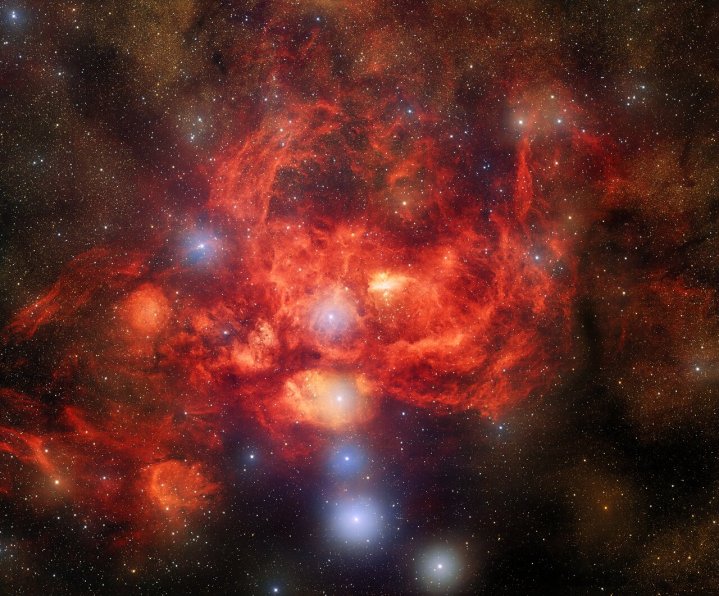
This striking image shows an object called the Lobster Nebula, which is 400 light years across and is located 8,000 light-years away. This image was taken using a ground-based instrument called the Dark Energy Camera, located on the Víctor M. Blanco 4-meter Telescope. The camera was originally used for a survey of the sky to research the strange phenomenon of dark energy. Since that survey was completed, the instrument has been used for a variety of other scientific purposes including snapping stunning images like this one.
This nebula is full of dust and gas and is an area where many new stars are being born. It is the radiation from these hot, young stars which illuminates the nebula and makes it glow.
Spitzer’s last hurrah
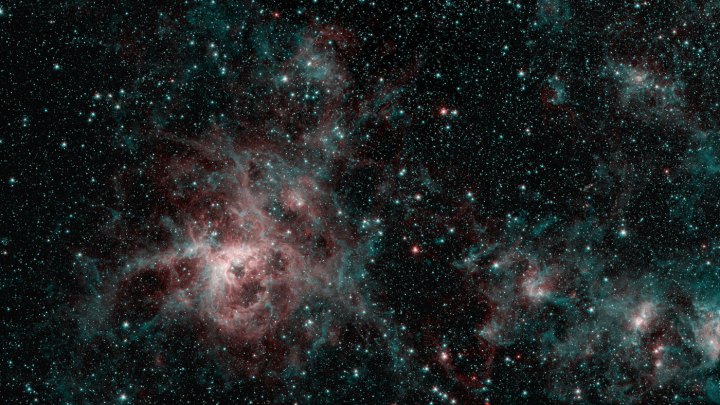
The James Webb Space Telescope is the most famous space-based infrared space telescope, but before it was launched there was another NASA space telescope looking at the universe in the infrared spectrum. The Spitzer Space Telescope was launched in 2003 and operated until 2020, as part of NASA’s Great Observatories program along with the Hubble Space Telescope, the Chandra X-ray Observatory, and the Compton Gamma Ray Observatory. These telescopes — of which Hubble and Chandra are still operating — paved the way for newer telescopes like James Webb.
When Spitzer reached the end of its life in 2020, scientists continued to use the data that it collected over its 16 years of observations. This image was released as a celebration of Spitzer’s achievements, showing the Tarantula Nebula. This particular nebula was chosen as it was one of the first targets that Spitzer imaged after its launch. This region was ideal to study using Spitzer and it is full of warm dust which can be seen in the infrared wavelength.
The lifetimes of stars
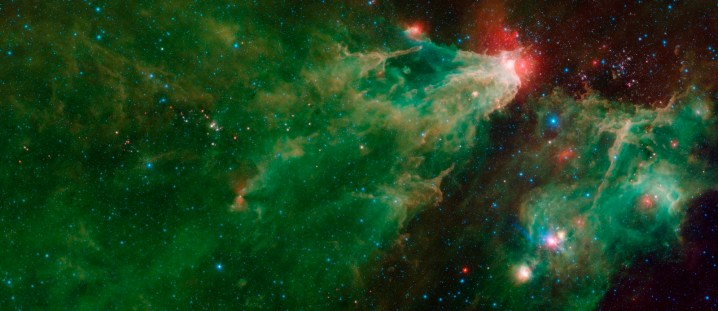
Some regions of space are particularly interesting to study because they feature multiple generations of stars, allowing scientists to learn about complex stellar lifecycles by looking in just one location. That’s the case with this image from the Spitzer Space Telescope of a pair of star nebulae containing the star clusters Cepheus B and Cepheus C, which hosts stars in various stages of life.
The green seen in this image represents a cloud of dust, also seen in orange, which is the swirling matter from which stars first form. In the smaller nebula on the right hand side you can see pink and white dots which represent particularly bright stars. At the tip of the nebula on the left is a bright red region where where stars are heating the nearby dust so much that it glows in the infrared, which is the wavelength instruments used for this image. And you can also see a band of darker material in the center, which is a particularly dense region of dust. The density is what makes it opaque to infrared light, but this area is far from empty — it is in fact a stellar nursery, where new stars are being formed.
The iconic Pillars of Creation
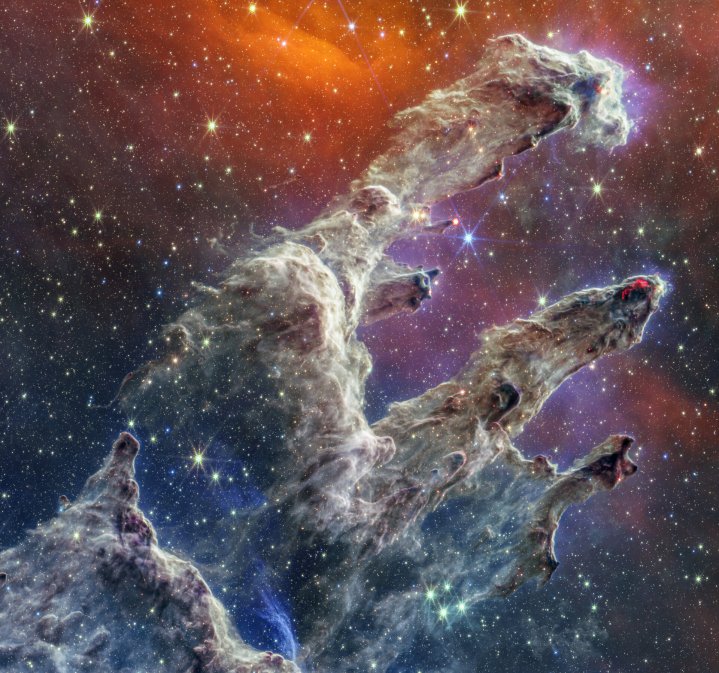
One of the most famous space images of all time is Hubble’s snapshot of the Eagle Nebula, better known as the Pillars of Creation. This stunning structure has enchanted viewers for decades, and a whole new generation of space observers has been introduced to the sight thanks to this image from the James Webb Space Telescope. While Hubble imaged the pillars in the visible light wavelength, Webb used its Near-Infrared Camera (NIRCam) and Mid-Infrared Instrument (MIRI) instruments to take this image of the familiar structure.
Looking in the infrared means that fewer stars are visible in the image compared to visible light versions, but more of the delicate structures of the dust which forms the pillars are revealed. The glowing tips of the pillars are areas of star formation, and the dust of the pillars is darker in areas where it is more dense.
Rover descending

As human achievements go, putting a rover on the surface of Mars is a pretty big one. But in some ways even wilder than that is being able to capture that rover as it lands for the first time. When NASA landed its Perseverance rover on Mars in February 2020, the world looked on with excitement. And then the world got to actually see the landing take place, when the rover later broadcast footage of the landing back to Earth. This was the first video footage of a landing taking place on Mars, and it was summed up by this iconic image of the rover being lowered toward the ground.
The image was captured from Perseverance’s descent stage, which was a small jet-powered craft that had thrusters pointing downward to help slow the rover in addition to a parachute. The rover was then lowered from the descent stage using cables, and when the rover was on the surface the cables were released and the descent stage flew away to prevent any chance of the rover getting tangled up. Perseverance continues to explore an area of Mars called the Jezero Crater, looking for signs of ancient life.
The great Southern Ring nebula
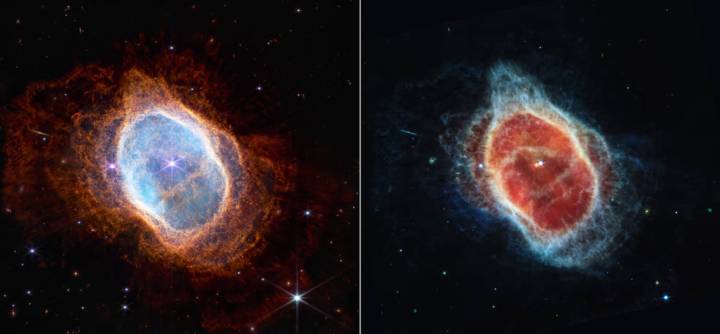
Another image shared in the batch of James Webb’s first images was this pair showing the Southern Ring Nebula. This structure was formed by a dying star, which shed its outer layers of gas. These layers traveled outward, forming a bubble-like structure of the nebula.
The pair shows the value of instruments which look in different wavelengths. Although all four of Webb’s instruments look in the infrared, the image on the left is from Webb’s Near-Infrared Camera and the one of the right is from its Mid-Infrared Instrument. Looking in the near- or mid-infrared highlights different portions of the image, such as the structure of the dust or the pair of stars orbiting close together at the heart of the nebula.
A galactic quintet
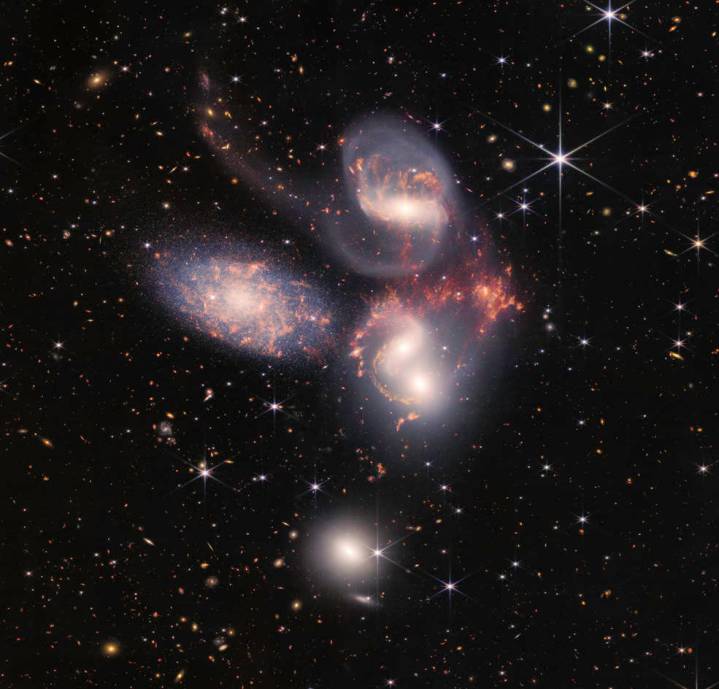
When seen at a large enough scale, even huge galaxies can look small. This image covers an enormous area, with the original clocking in at over 150 million pixels. It shows a group called Stephan’s Quintet, with four galaxies in a group of five being so close together that they are in the process of merging into one.
When galaxies collide, as terrifying as that prospect sounds, the process is typically very slow. Because there is so much space between stars and planets, it’s rare for actual stars to collide. But the tremendous forces of gravity that come into play when objects this massive interact can pull and distort the galaxies into strange shapes. It’s not uncommon to see two galaxies in the process of merging, but this object, captured by the James Webb Space Telescope, is unusual for having so many galaxies all interacting at the same time.
A hellish planet
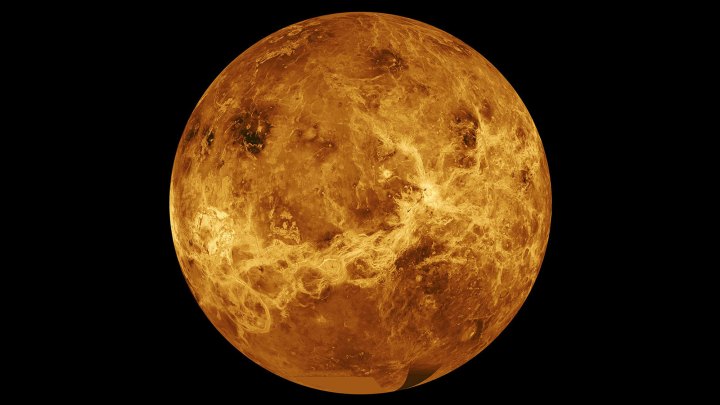
Venus might be the planet next door to us, but there’s still a lot we don’t understand about it. With its baking hot surface temperature and atmosphere so thick that it exerts immense pressure on anything on the surface, plus clouds which obscure much of the view from orbit, it’s not an easy place to study. There have been missions there which have peeled back some of the mysteries though, like NASA’s Magellan mission launched in 1989 or the Pioneer Venus Orbiter launched in 1978.
Data from both these images was woven together to create this image of the planet as seen from orbit. A very few missions have even landed on the surface of the planet, like the USSR’s Venera missions in the 1960s, 1970s, and 1980s. Venera 9 was the first mission to land on the surface of Venus in 1975 and survived for roughly an hour, even sending back images from the surface.
The outbursts of a newborn star
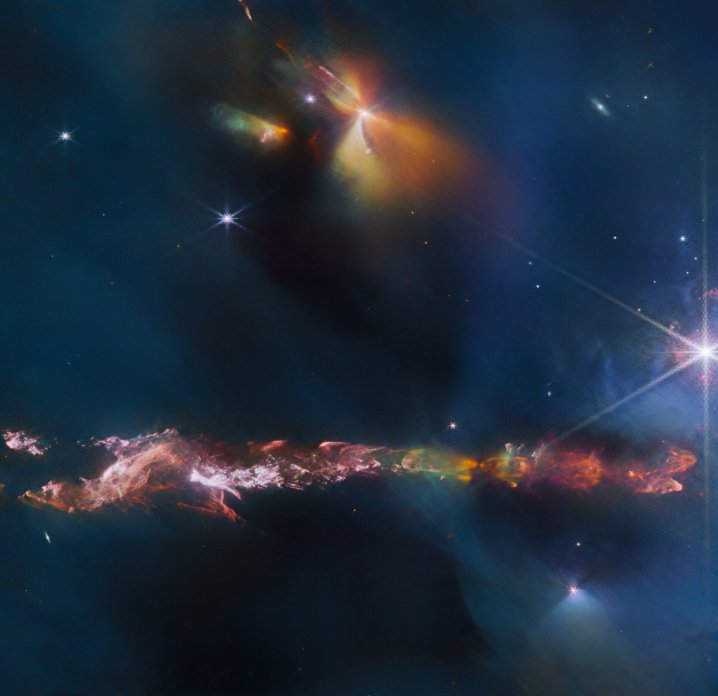
Stars are big and bright almost by definition, but they can be particularly active when they are young. Newly born stars can give off huge quantities of radiation which shapes the environments around them — as seen in a vivid example here. Some particularly active newborn stars can gives off jets of gas, with great quantities of energy being thrown off from a star’s two poles. That forms striking objects like this one, called a Herbig-Haro object.
This particular Herbig-Haro object is called HH 797, and was imaged using the James Webb Space Telescope’s NIRCam instrument. As the star throws off its jets, these excite the molecules of gas which they pass by and make them glow. The resulting structures can be more than a light-year across, making them visible from great distances.
Untethered in space

Most spacewalks or extravehicular activities (EVAs) performed today are around the International Space Station, with astronauts occasionally going to the outside of the station to make repairs or to perform maintenance. These can be grueling affairs, typically lasting six or seven hours and requiring tremendous physical and mental fortitude, and they generally involve the astronauts being tethered to the outside of the station using hold down points dotted all over the exterior for just this reason.
But for a while, there was an era of unethered spacewalking. In the 1980s, during the Space Shuttle era, astronauts went untethered, with no physical anchor to hold them in place. Instead, they use a unit attached to their spacesuit called a Manned Maneuvering Unit (MMU) which allowed them to move around using thrusters. This image shows the tenth Space Shuttle mission, STS-41-B, during which two astronauts (Bruce McCandless and Robert L. Stewart) performed the first ever untethered spacewalk. Here Stewart can be seen floating over the Earth, a few meters from the Space Shuttle Challenger.
A stellar nursery seen in the infrared
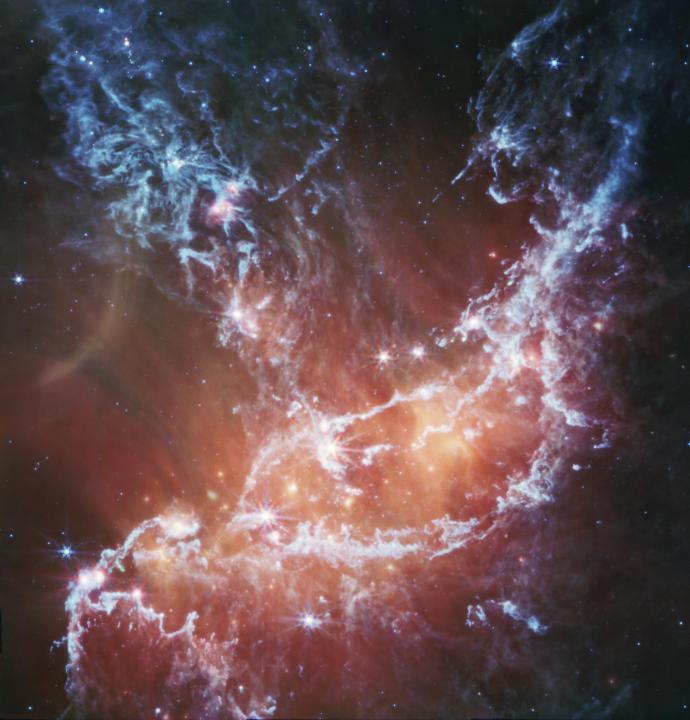
Our galaxy, the Milky Way, has a number of small satellite galaxies which are gravitationally bound to it, including the well-known Small Magellanic Cloud. Within this galaxy is a busy star-forming region called NGC 346, captured by the James Webb Space Telescope’s Mid-Infrared Instrument. This highlights the dust in the region, with warm dust shown in red and molecules called polycyclic aromatic hydrocarbons shown in blue.
A stellar nursery in the optical
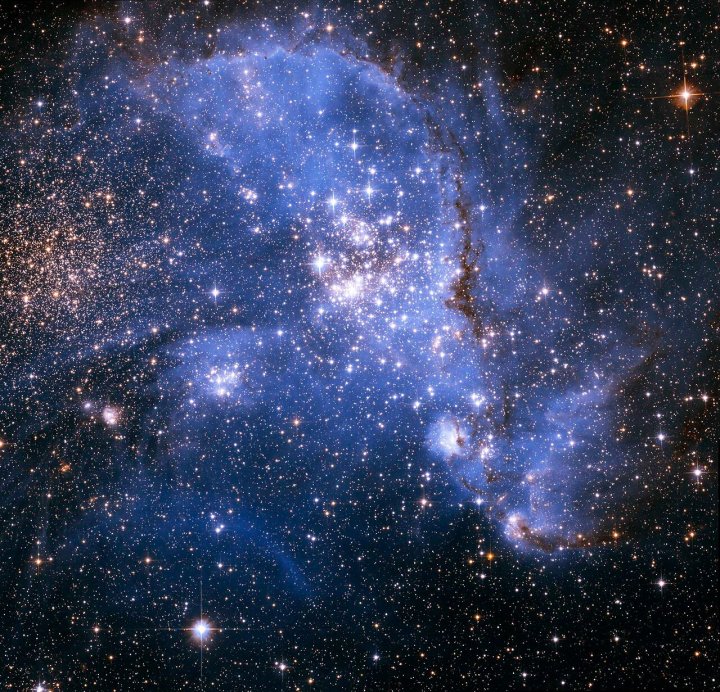
The same stellar nursery as the previous image was captured this time by Hubble. This view highlights the thousands of stars visible in the background, with the swirls of gas looking more ghostly and insubstantial. The many bright dots near the center of the cluster are young stars recently formed in this river of gas, which is studied by scientists who are looking to learn more about star formation and how it is fed by the spiral of gas in this cluster.
Honeycombs on the sun’s surface
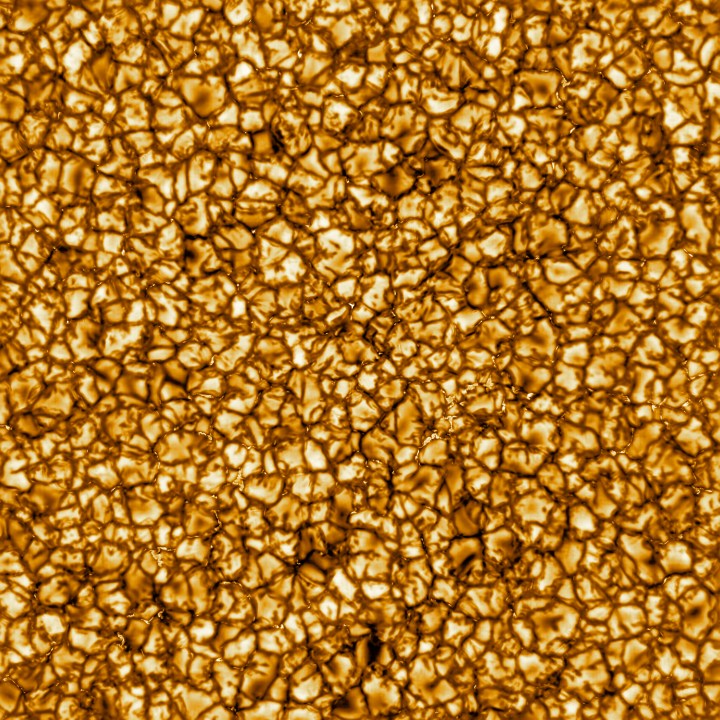
Studying the sun is challenging — it’s so bright that it overwhelms most instruments. But the Daniel K. Inouye Solar Telescope is designed specifically for studying the sun, trying to answer questions such as why the sun’s corona is so much hotter than its surface, and how the boiling plasma that it sends out into space affects the local environment and even how its effects spread out into the solar system, interacting with Earth’s atmosphere in a phenomenon called space weather.
After 10 years of planning and seven years of construction, in 2020 the first image from the new telescope was released. It shows the surface of the sun in more detail than ever before, showing the cell-like structures which cover the surface. Each of these structures is the size of Texas, with hot plasma rising to the middle of each vell.
An act of galactic cannibalism

When two galaxies collide, the outcome can depend on the mass of each galaxy — and sometimes that’s an unfairly matched fight. That is the case in this image taken by the Dark Energy Camera, which shows a “tug of war” between one large spiral galaxy called NGC 1532 or Haley’s Coronet and its much smaller neighbor, the dwarf galaxy NGC 1531. Even though the dwarf galaxy is in the process of being absorbed into the larger spiral galaxy, its passage isn’t without drama: the gravitational forces are tugging at the spiral galaxy and pulling its spiral arms out of alignment. You can see the twisted spiral arm at the top of the larger galaxy, with its streamer of stars and gas being bent around the small, bright blob of the dwarf galaxy.
A spiraling Cartwheel Galaxy

Some galaxies are famous for their scientific interest or their beauty, but others are famous for their charming shapes. The Cartwheel Galaxy is one of the latter, given its name for its obvious resemblance to a wheel with spokes reaching out from the galactic center. Located 500 million light-years away and imaged using the James Webb Space Telescope, this galaxy is really composed of two main rings: a smaller and bright inner ring, and a more diffuse outer ring. This structure was formed from two galaxies colliding at unusually high speeds, with effects rippling outward from this epic event. The central ring is brighter because it is packed with hot dust, while the outer ring glows as it expands outward and collides with gas in the surrounding space.
The potential for extraterrestrial life

Of all the places that we might want to look for life beyond Earth in our solar system, some of the most promising options are not planets but moons. Moons like Europa, which orbits Jupiter, are known to have a thick, icy crust over an ocean of liquid water where life could potentially develop. This image of Europa was taken by NASA’s Galileo spacecraft which passed by in the late 1990s. Data from the mission was puzzled together to create this image of Europan in realistic color, designed to mimic how the moon would appear to the human eye. Long cracks and ridges dot the surface of the ice crust where it has broken and then refrozen. These cracks are caused by the gravitaiontal forces of the huge planet of Jupiter, which exerts significant effects on its moons.
Hubble finds an Einstein Ring
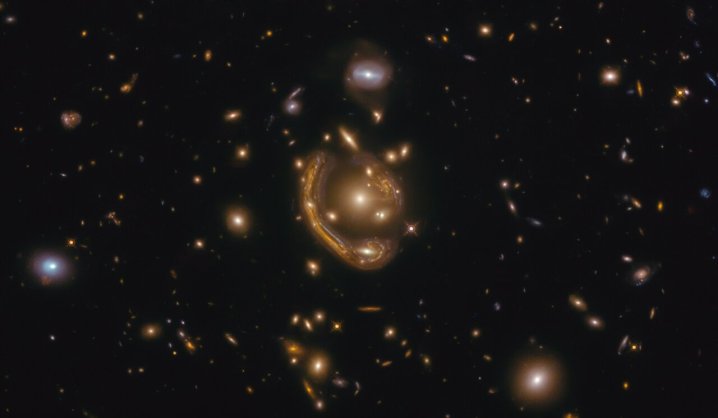
This image from the Hubble Space Telescope shows a rare phenomenon called an Einstein ring. When light is traveling from a distant object, it can be bent by the forces of gravity if a large enough mass is in front of it. This often leads to galaxies which appear distorted or stretched in deep field telescope images, in a phenomenon called gravitational lensing. But very occasionally, this distortion makes a galaxy appear almost completely ring-shaped, in which case it is named an Einstein ring in honor of Einstein’s theory of relativity.
This Einstein ring is called GAL-CLUS-022058s, and is famous for being the largest and one of the most complete Einstein rings ever observed. It has been nicknamed the Molten Ring, for its melty and swirly appearance, and its located in the southern hemisphere in the constellation of Fornax.
Space Shuttle rising
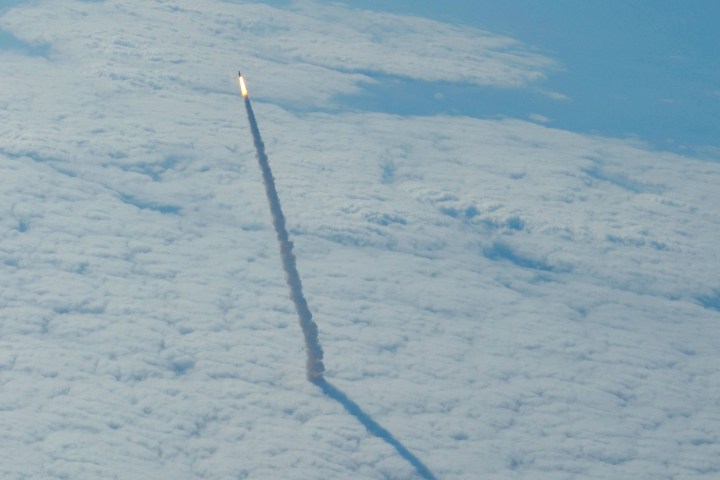
Before the SpaceX Crew Dragon carried its first astronauts to the International Space Station in the Demo-2 mission in 2020, the U.S. had not launched a crewed orbit spaceflight mission since the ending of the Space Shuttle program. This image shows one of the final flights of the Space Shuttle, with the launch of the Endevour in 2011 which was its last trip to space. Mission STS-134 was the 25th flight for this shuttle and carried a crew of six along with various pieces of hardware and research to the International Space Station. After the next mission STS-135 used the Atlantis shuttle, the U.S. would not launch astronauts in its own vehicle for nine years.
The Ring Nebula

Another famous and beautiful nebula is the Ring Nebula, named obviously for its ring shape. At the heart of the nebula is the hot, dense core of what was once a massive star but is now a remnant called a white dwarf. When the star was coming to the end of its life, it cast off its outer layers of gas and these layers traveled out into the space around it. As the gas interacted with the nearby environment it continued to glow, creating this structure called a planetary nebula. Despite the name, this type of nebula has nothing to do with planets. But they were given the name by early astronomers who saw their round shapes and thought they were looking at far-off planets.
A new view of the Horsehead
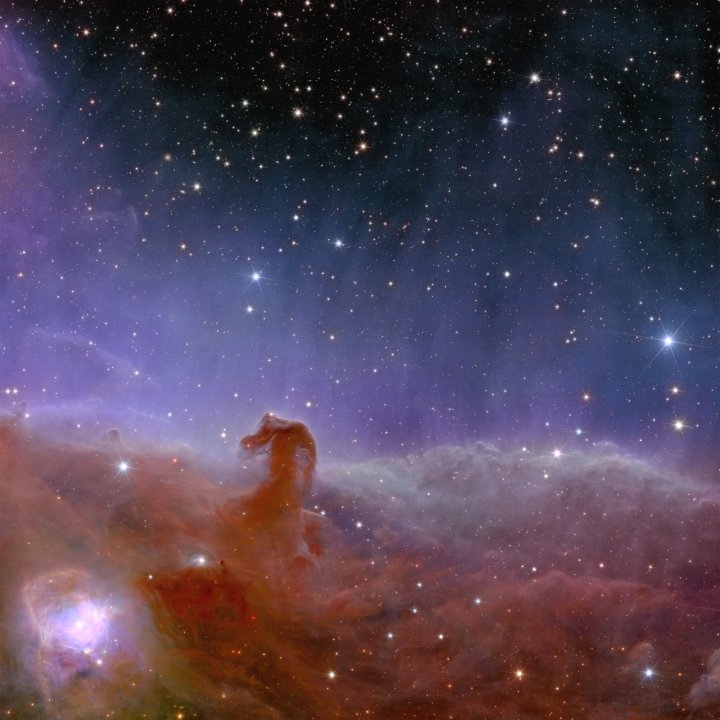
The famous Horsehead Nebula has been imaged by many telescopes over the years, including an iconic image from the Hubble Space Telescope. This version of the stunning nebula, named for the distinctive shape jutting up from the clouds of dust and gas, was taken by the Euclid Space Telescope in celebration of its launch and commissioning in 2023. The telescope is designed to observe distant galaxies at a large scale to learn about the mysteries of dark matter and dark energy, but it can also be used to capture beautiful views like this one in fablous detail. The nebula is also known as Barnard 33, and is located 1,375 light-years away in the constellation of Orion. It is one of the busiest giant star-forming regions close to Earth, making it a popular target of study.
Looking at the face of the sun
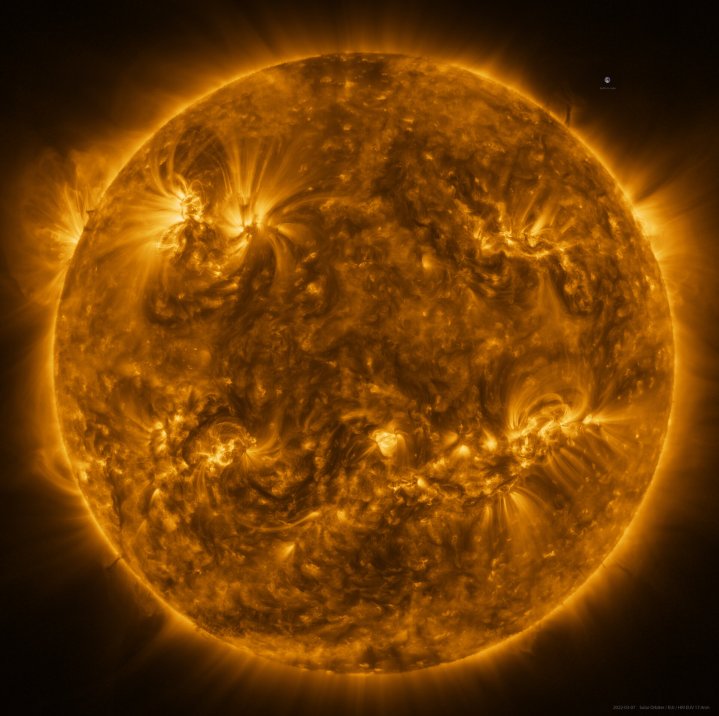
The European Space Agency’s Solar Orbiter is a spacecraft which orbits the sun to study it using instruments like its Extreme Ultraviolet Imager, a camera which operates just beyond the range of human vision in the ultraviolet. Using 25 images from this instrument taken in 2022, this mosaic was built up showing the entire face of the sun.
To give a sense of perspective, the researchers included a tiny image of the Earth, not in its true position but to scale in terms of size. It’s the tiny little dot in the top right of the image. The sun’s diameter is over 860,000 miles. According to NASA, that means that if the sun were the size of a typical front door, then the Earth would be the size of a nickel.
Hubble mosaic of the Sombrero Galaxy
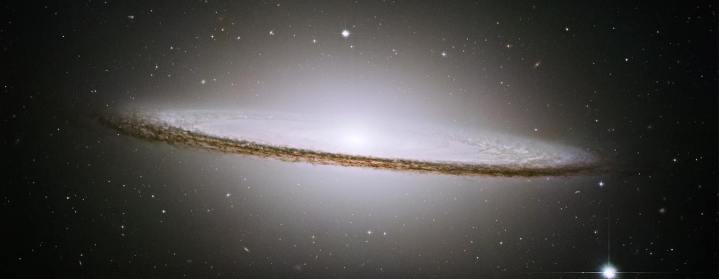
Known as the Sombreo galaxy because of its resemblance to the iconic Mexican hat, this image was captured using the Hubble Space Telescope. Also known as Messer 104, the galaxy has a distinct bulging white core surrounded by thick lanes of dust, seen largely edge-on from the perspective of Earth. This galaxy is a favourite target of telescopes because of its distinctive shape and the fact it can almost but not quite be viewed by the naked eye. At a tremendous 50,000 light-years across and located 28 million light-years away, this image was one of the largest Hubble mosaics ever assembled when it was first released in 2003.
Westerlund 2
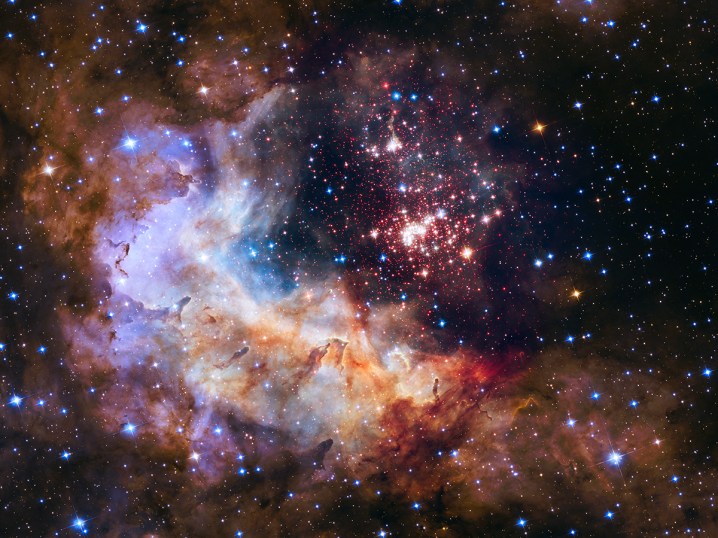
The Hubble Space Telescope has been illuminating the wonders of space since 1990, and as part of that long line of achievements, researchers have released special celebratory images for particular anniversaries. This image was released for Hubble’s 25th anniversary and has become one of the telescope’s most iconic and recognizable images.
It shows a cluster called Westerlund 2, with a central star cluster where stars gleam like jewels and surrounding regions of dust and gas sculpted into complex shapes. It combines data from two of Hubble’s instruments, the Advanced Camera for Surveys and the Wide Field Camera 3, and includes observations in both the visible light and near-infrared wavelengths.
Saturn’s rings shine
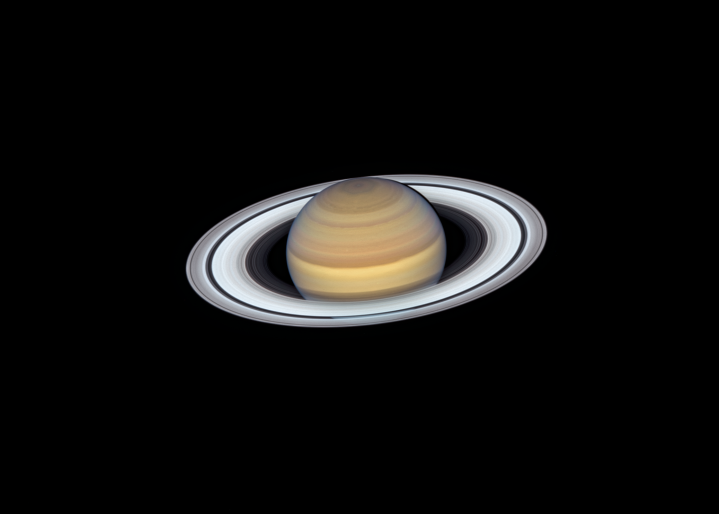
Saturn is one of the most striking planets in the solar system, with its delicate bands of color and its iconic rings. This image, taken by the Hubble Space Telescope in 2019, shows a beautiful view of the planet and in particular its rings.
The rings aren’t solid, but are rather disks made up of tens of thousands of small icy particles and dust. There is an ongoing debate about exactly how old the rings are, as data from Cassini seems to suggest they are relatively much younger than would be expected given that rings are generally thought to form around the same time a planet forms. Exactly how these rings form is also the subject of ongoing research.
A martian sunset
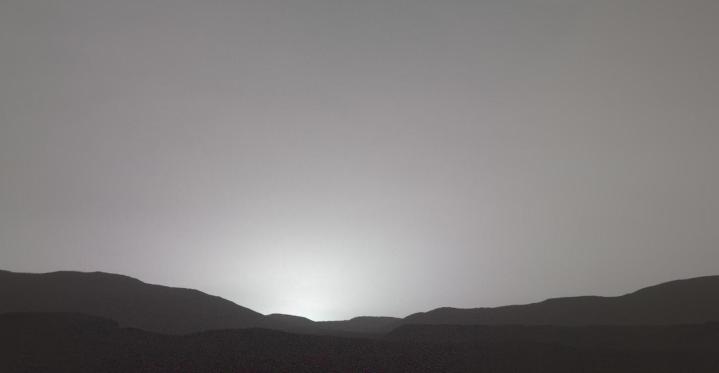
As well as capturing images of the martian surface, various rocks for study, and even of themselves, the Mars rovers occasionally look up to capture the martian sky. In this image, taken by the Perseverance rover in 2021, you can see the otherworldly sight of a martin sunset. Taken just as the sun was dipping behind the hills using Perseverance’s Mastcam-Z instrument, it shows the glow of the sun over the rocky landscape. Sunsets on Mars are typically a blue color because of fine dust in the atmosphere which filters the light to make it bluer, but in this case there was a lower level of dust in the atmosphere so the colors are more muted.
A galactic hit and run

Sometimes galaxies can collide, and the results can be dramatic. This image from the Hubble Space Telescope shows a stunning view of the galaxy UGC 10214, known as the Tadpole for it long tailed shape. This galaxy acquired its unusual tail due to a hit and run with another galaxy, visible as a small blue shape in the top left, which created gravitational interactions that pulled out the long tail of stars and gas as it passed by. The tail is more than 280,000 light-years long,
Ocean moon
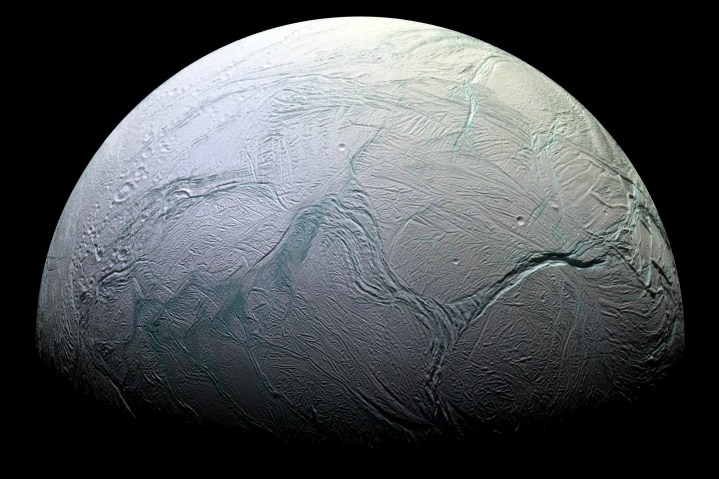
Another famous icy moon is Saturn’s moon Enceladus, which is another prime candidate in the search for life within the solar system. This image of the moon was snapped from the Cassini mission when it passed by in 2005, getting an up-close glimpse at the most reflective object in our solar system. The image is a mosaic made up of 21 images, worked together to give a view of the features on the icy surface. This image is false color, however, so it doesn’t appear how the moon would appear to the human eye. Instead, the blue tint helps to highlight the fractures on the surface, known as tiger stripes.
A Mars selfie
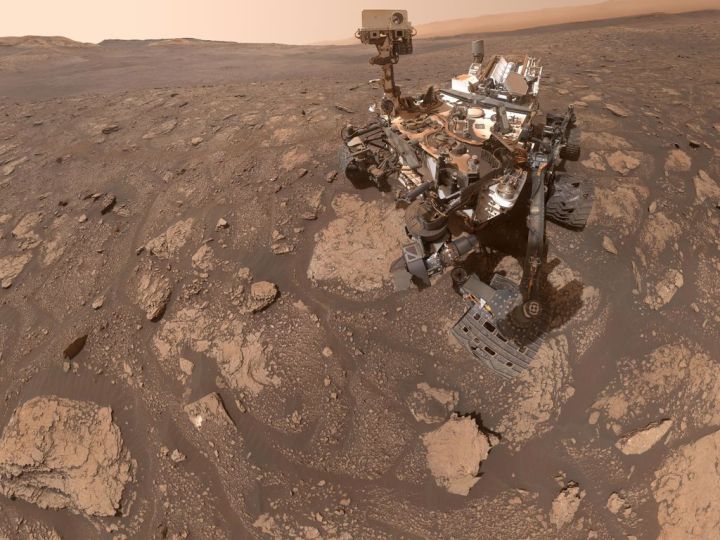
It isn’t only humans and the occasional curious animal confronted with a wildlife photographer’s camera that like to take selfies. The Mars rovers Perseverance and Curiosity have long robotic arms which they can use to manipulate rocks and other samples, or, as in this case, to snap a selfie. With a camera called the Mars Hand Lens Imager located on the end of its robotic arm, Curiosity was able to take this image of itself on the martian surface in a region called Mary Anning in 2020.
Billions and billions, indeed
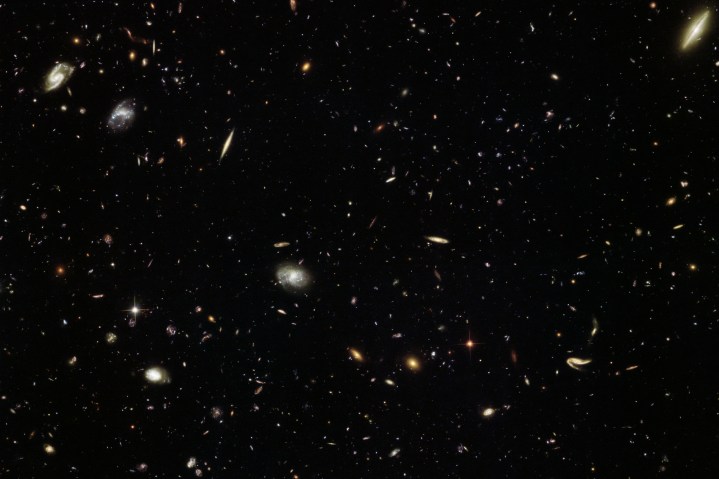
One of the incredible abilities of the Hubble Space Telescope is to take images not only of particular cosmic objects, but also of great patches of sky. When focused on an area of the sky which is mostly empty, these images reveals thousands of background galaxies of all different types. They also reveal very distant galaxies, which, because of the expansion of the universe, are therefore very old. Scientists are particularly interested in studying these galaxies which formed in the early period of the universe.
These images are known as deep field images, and this Hubble image shows thousands of the galaxies that are visible in the constellation of Leo. It was captured for Hubble’s Frontier Fields campaign, which investigated enormous galaxy clusters and searched for extremely distant galaxies.
Lesser-known “spots” in our solar system
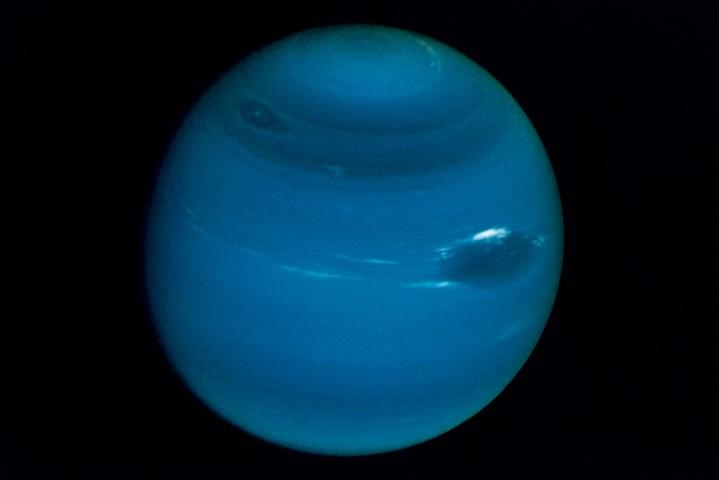
When Voyager 2 was still making its way past the outer planets in the 1980s, it snapped this image of Neptune as it passed. Or rather, it snapped 42 photos which were stitched together into this composite of the rare-studied planet. Like Jupiter’s famous Great Red Spot, Neptune has a Great Dark Spot of its own which is thought, like Jupiter’s, to be a huge storm larger that the size of the Earth. This storms was estimated to have wind at speeds of up to 1,500 miles per hour, but unlike Jupiter’s storm which has persisted for hundreds of years, Neptune’s great storm seemed to be a transitory event as it had faded by the time Hubble came to photograph the planet in 1994.
Fixing our eyes in the sky
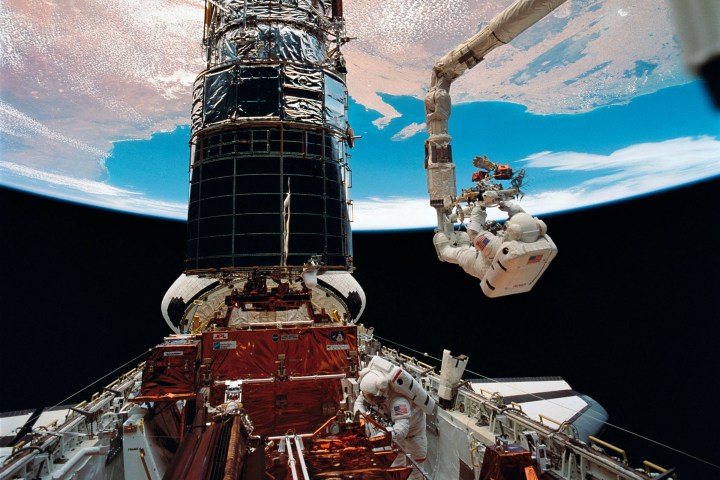
It’s easy to forget, now that the Hubble Space Telescope is so beloved and successful, but when it launched it was beset with problems. The biggest issue when it launched in 1990 was that a tiny, almost impercetible flaw in its priamry mirror rendered its images blurry. The images were still useful for determined scientists, but the public was unimpressed and the telescope was the butt of many a joke on late night TV.
That changed with the first servicing mission sent to the telescope in 1993. Using the Space Shuttle, astronauts were sent to the telescope’s orbit around Earth to perform maintainance and corrections, particularly on the primary mirror. This image shows that first servicing mission, with astronaut F. Story Musgrave anchored to the robotic arm of the Space Shuttle to work on Hubble, with astronaut Jeffrey A. Hoffman located below. The first servicing mission corrected the fuziness issue, and a number of missions afterward continued to upgrade and maintain the telescope to make it the much-loved tool it is today.
ISS solar transit
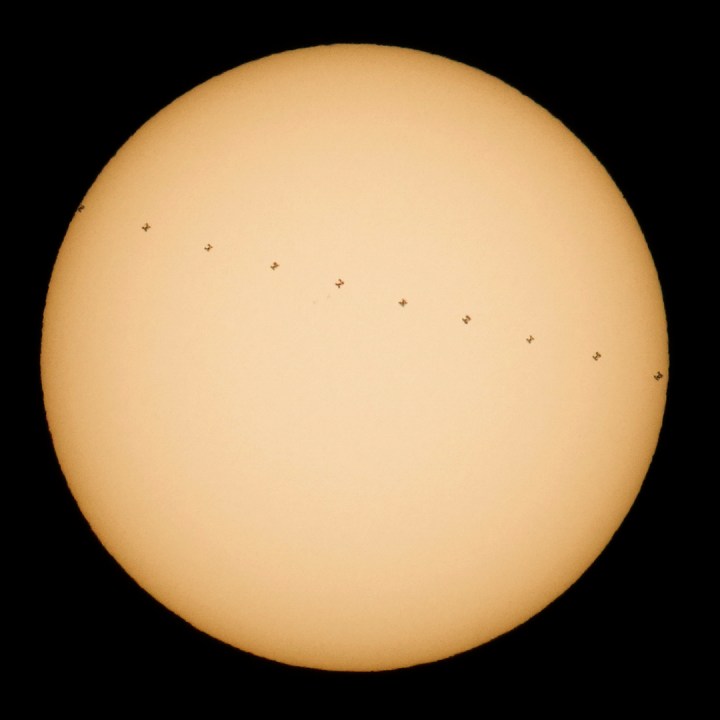
The International Space Station is one of the great examples of international cooperation in science, allowing the continuous presence of humans in space for more than 20 years. Crews of typically between three and ten people occupy the station, with astronauts representing the U.S., Russia, Europe, Japan, and more. This image is a composite of 10 separate frames showing the ISS as it passes across the face of the sun, captured in 2016 from Newbury Park, California.
Pluto’s polygons
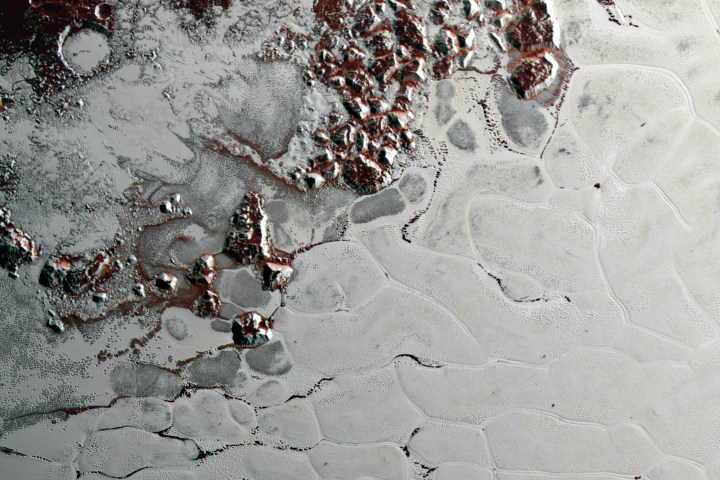
Pluto may no longer be considered a planet, but it’s still a fascinating target of curiosity. Now known as a dwarf planet, it is extremely distant and therefore rarely studied. However, the NASA mission New Horizons did get close to Pluto in July 2015, snapping images and showing some stunning features on its surface. This area, known as Sputnik Planum, is covered in icy cells which aren’t static. Rather, they are constantly turning over due to a process called convection, causing fresh young material appearing on the surface. NASA likened the process to a cosmic lava lamp renewing Pluto’s surface material.
Geometric cyclones
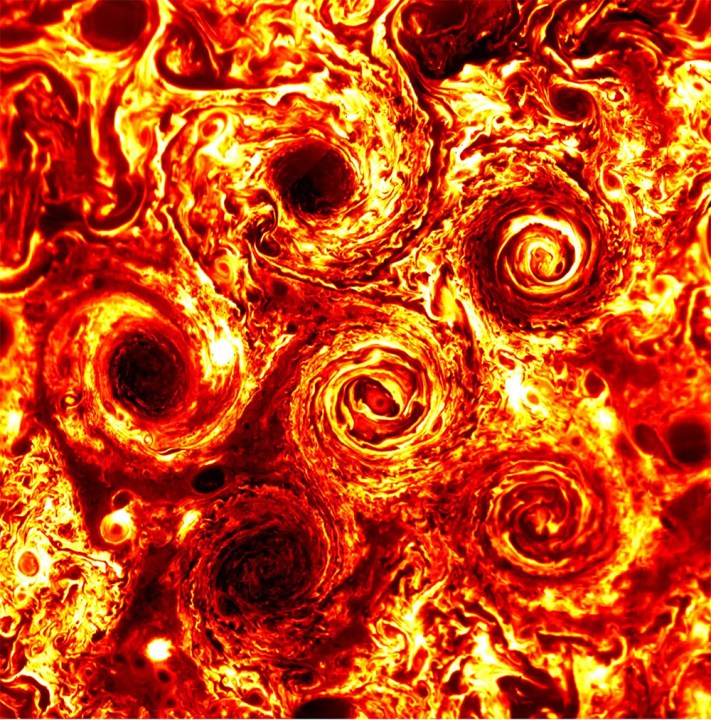
As weird sights of the solar system go, this has to be up in the top list. This is a group of cyclones around Jupiter’s south pole, which form a geometric formation. The storms were observed using infrared data by the Juno spacecraft, which noticed several of these storms surrounding one massive cyclone. As scientists observed the feature over time, they even spotted a new cyclone joining the fray in 2019 although it was a relatively small one — at “just” the size of Texas.
The storms are thought to be related to Jupiter’s heat and high speed of rotation, as the lower levels of the atmosphere give off a lot of heat and the planet rotates so fast that a day there lasts only around 10 hours.
First flight

When the Perseverance rover landed on Mars in 2020, it had a special companion along for the ride with it. The helicopter Ingenuity was designed as a technology test, to see whether it was even possible to fly a helicopter on another planet. Mars has extremely thin atmosphere, so the helicopter needed large rotor blades that spun at extremely high speeds to lift it off the surface, even with the planet’s weak gravity. Originally intended for just five flights over 30 days, the helicopter was so successful that it made 72 flights over three years before being permanently grounded due to damage to one of its rotors.
This image shows the helicopter on the surface of Mars, and was taken by the Perseverance rover when it was nearby in 2023. This was two years since it took its first flight, and dust has built up on its body and solar panels.
The deepest deep field

When the James Webb Space Telescope was launched in 2021, one of the hopes was that it would be able to look for some of the most distant galaxies. Due to the expansion of the universe, the oldest galaxies we know of are very distant from us, so to study them scientists needed a special tool. Webb looks in the infrared wavelength, which is useful because of a phenomenon called redshift: when a thing is moving away from us, its light gets stretched and shifted toward the red end of the spectrum. Some of these very distant galaxies are so far away that their light is shifted completely out of the visible light range and into the infrared, which is why a special instrument like Webb was needed to observe them.
In 2022, scientists released the first full image from Webb: this view of thousands of galaxies, known as Webb’s first deep field image. It shows galaxy cluster SMACS 0723, with many galaxies that were visible for the first time using its infrared instruments.
More than a “red” planet
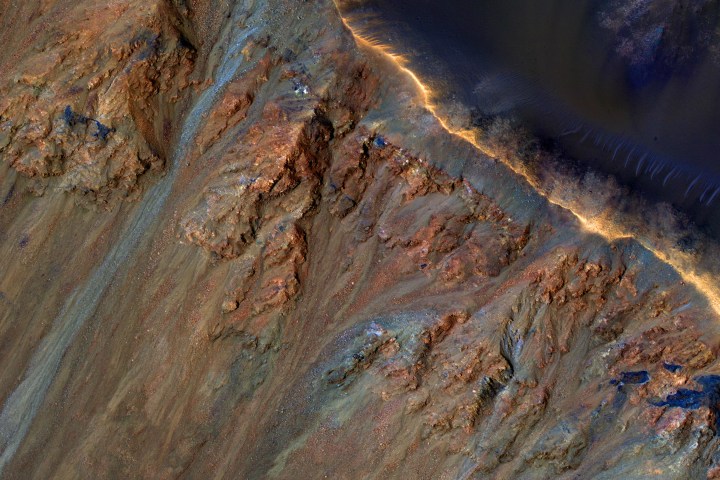
We think of Mars as being red or dusty orange, and many people picture its surface as being like a desert with some rocks. But the planet has a great variety of geological features on its surface, such as this image taken by NASA’s Mars Reconnaissance Orbiter (MRO). This region is known as the Krupac Crater, with its gullies and steep slopes. The image has been color enhanced to show off some of the features which are unusual for the area. Although large gullies are commonly found closer to the poles, this crater is just south of the equator.
A cosmic question mark

In 2023 a James Webb image captured the public by storm, as it showed a galaxy that looked extremely familiar shape. Shaped like a question mark, this little piece of space trivia became a sensation as people found it compelling, existential, and fascinating.
The shape is likely caused by a galaxy gravitationally interacting with another nearby galaxy, according to experts. This image is just a small corner of a much larger image of Herbig-Haro object 46/47, which is itself a beautiful image of the outbursts caused by a pair of young stars. But it’s this particular little corner with its strangely shaped galaxy which has left a lasting impression on many people. It just goes to show that in a large enough universe, practically anything is possible.
X-rays from Uranus

Often overlooked, Uranus is so far away that it isn’t often visited by spacecraft. However, it is viewed by ground-based telescopes, with sometimes stunning results. When seen in the visible light wavelength, Uranus typically appears blue and fairly uniform. But when seen in the X-ray wavelength, the planet comes alive.
This image combines visible light observations with X-ray observations from the Chandra X-ray Observatory, showing the glow of X-rays that the planet is emitting. Researchers aren’t quite sure what the cause of this emission is, but similar X-ray emissions come from Jupiter and Saturn because of the way that those planets reflect sunlight, so that is part of the reason. but there could be other processes at work as well.
Blue skies on the red planet
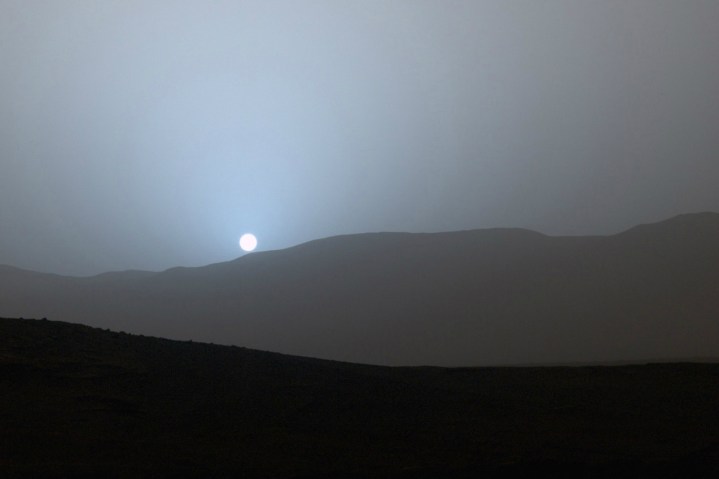
This image from the Curiosity rover shows the strangeness of Mars in full effect. Taken between the frequent dust storms which roll across the surface and which can even build up into global events, it shows a time at which there was a large amount of dust in the atmosphere. Curiosity took an image looking skyward to document this weather pattern, and it came back with this striking visual. The dust in the air absorbs certain wavelengths of light, resulting in this stunning blue color.
Sparking Orion
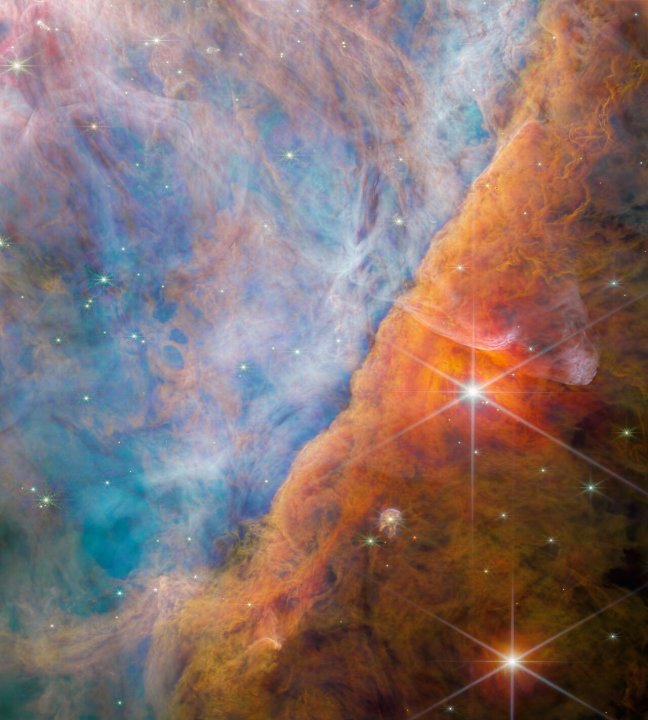
The Orion nebular is frequently studied when scientists want to learn about star formation, as it is a busy area in which many young stars are born. The image from the James Webb Space Telescope’s NIRCam instrument shows a region called the Orion Bar, where many hot young stars are giving off harsh radiation which illuminates the nearby dust and gas. The image was taken as part of research into the way that ultraviolet radiation from young stars impacts the molecular makeup of disks of dust and gas. The radiation erodes regions within the cloud which creates the void structures which appear as darker regions in the image.
ISS power upgrade
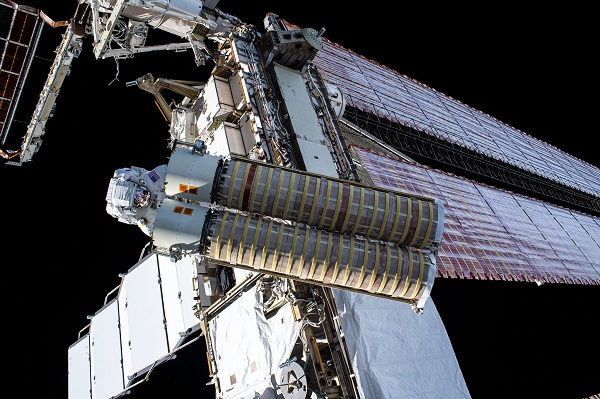
The International Space Station, like any other structure, requires period maintenance to keep it in top condition. The ISS had an aging power system with old solar panels that were no longer as efficient as they were when they were new, so astronauts began a program to upgrade those panels and keep the station’s power well topped up. In this image, NASA astronaut Shane Kimbrough carries one of the new solar panels, called ISS roll out solar arrays (iROSAs) toward its new location on the outside of the space station in 2021. The panels roll out to deploy, and even though they are smaller than the old panels they will deliver more power because of the increasing efficiency of solar panel technology.
Juno beholds a Jovian giant
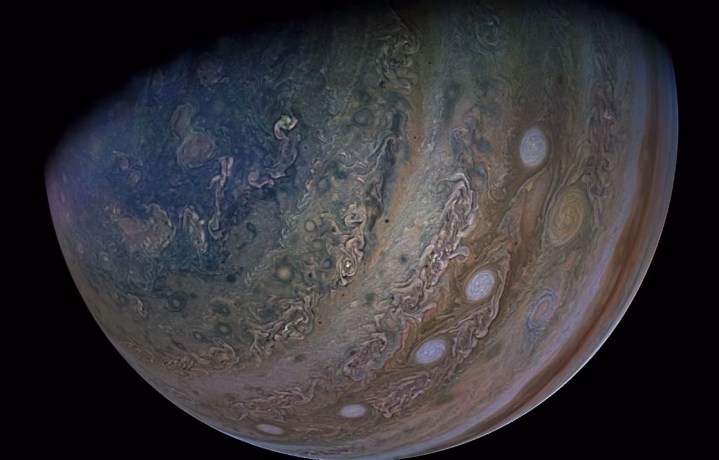
As the Juno spacecraft orbits around Jupiter it studies not only the planet but also its nearby moons. Jupiter is famous for its orange color, but this image constructed from JunoCam footage shows the complexity of the planet’s bands of atmospheric activity. The Jovian atmosphere has several layers with gases moving between them in a complex pattern, while from orbit instruments mainly only observe the tops of the clouds. This is a still from a video animation put together from JunoCam images showing a “starship captain’s eye view” of the planet.
Curvature of the Earth
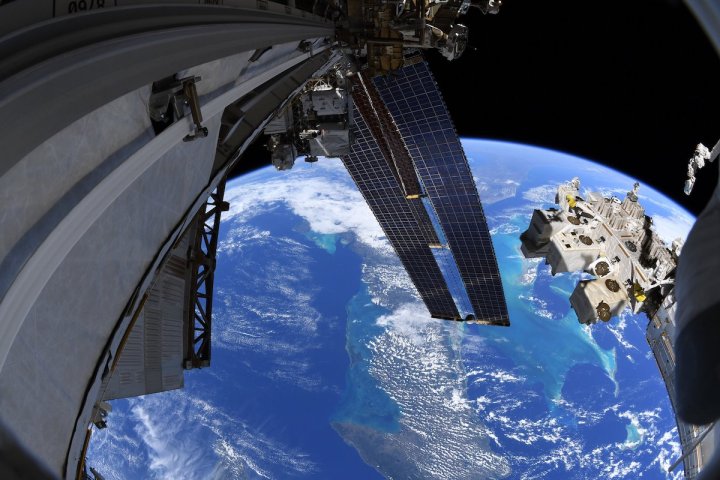
Some views are totally unique from space, like this photo snapped from the International Space Station. Taken by NASA astronaut Thomas Marshburn in 2022, it shows the curvature of the Earth as seen from the station, with the Caribbean Sea visible below beyond the station’s solar panels. The station orbits at an altitude of around 250 miles above the Earth’s surface, and astronauts frequently snap photos of the incredible views they experience and share them on social media.
The rings of Uranus
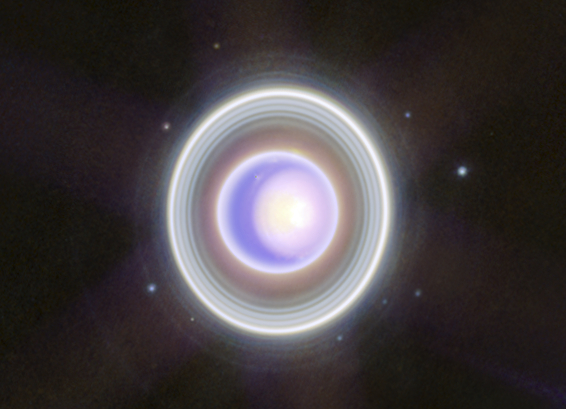
When you think of ringed planets, your mind likely goes straight to Saturn. And indeed, Saturn’s rings are spectacular. But you may not know that Uranus also has a stunning selection of rings — they are just almost invisible in the optical wavelength, in which human eyes seen. When the James Webb Space Telescope looked at Uranus in the infrared, it captured this incredible image of the rings and some of the many moons of Uranus. Taken with Webb’s NIRCam instrument, the image shows even the rarely-seen Zeta ring, which is a very faint faint close to the planet’s surface.
Moments before impact
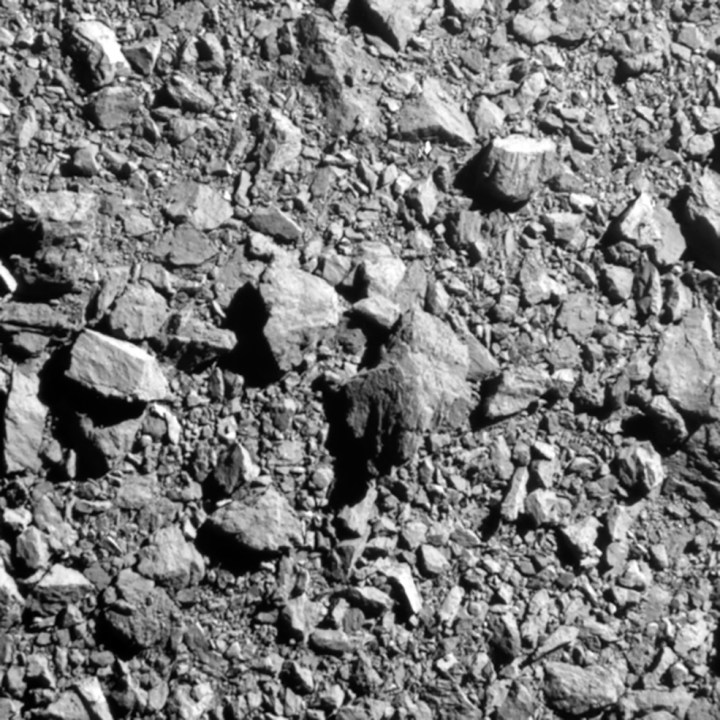
In 2022 NASA attempted a mission that no one had tried before: deliberately crashing a spacecraft into an asteroid in a test of planetary defense. The asteroid in question, Dimorphos, wasn’t actually a threat to planet Earth, but NASA wanted to test whether it was possible to change the orbit of such an asteroid in case one did ever threaten Earth in the future. This image is from moments before the spacecraft, called Double Asteroid Redirection Test or DART, smashed into the surface of Dimorphos. It did succeed in changing its orbit, demonstrating that it is feasible to use this kind of approach as a method of planetary defense.
Pluto’s sapphire silhouette
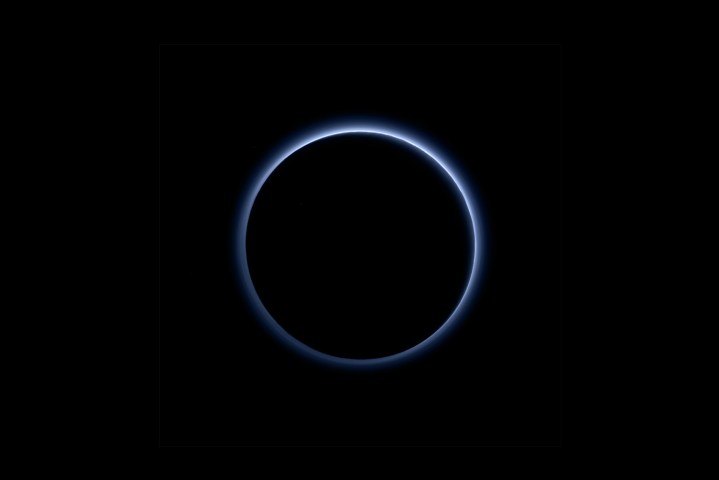
Pluto was visited by the New Horizons spacecraft in 2015, and during that time the spacecraft took this stunning image of the planet. It shows Pluto backlit by the sun, with the hazy layers of blue surrounding it. This layer is thought to be photochemical smog, which occurs when sunlight illuminates the methane and other gases which comprise the dwarf planet’s thin atmosphere.
The Veil Nebula
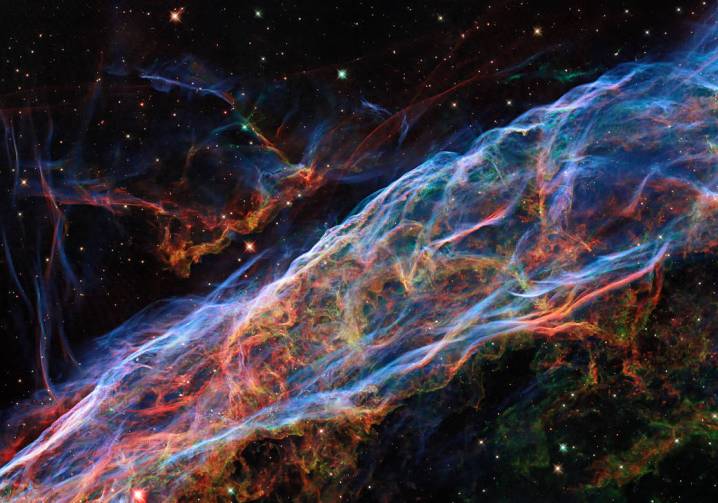
The Veil Nebula is famous for its stunning shape, with a thread-like structure with ionized gas winding thought it. It was first imaged by Hubble in 2015, but this version is an updated image released by Hubble scientists in 2021. The newer version uses the same data as the old version, but has been processed with new and improved image processing techniques which allow it to show more details that were visible before. The different colors come from different gases and temperatures, like ionized oxygen, hydrogen, and nitrogen.
The beauty of Jupiter
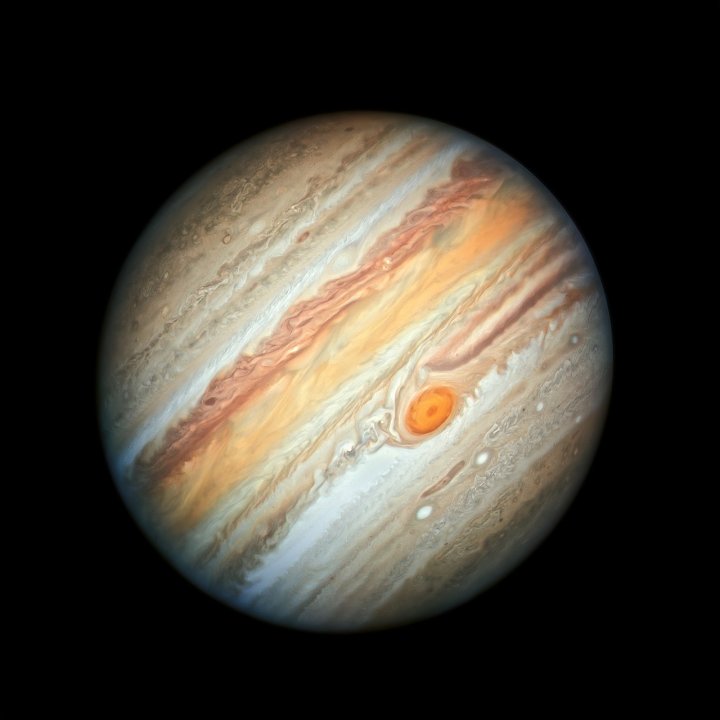
There’s nothing quite like a Hubble portrait, and this is a particularly elegant example. Released in 2019 and taken using Hubble’s Wide Field Camera 3, it shows Jupiter when it came at its closest point to the Earth. The portrait shows features like the stunning Great Red Spot, an enormous storm bigger than the entire Earth which has been raging for hundreds of years.
An exploded star
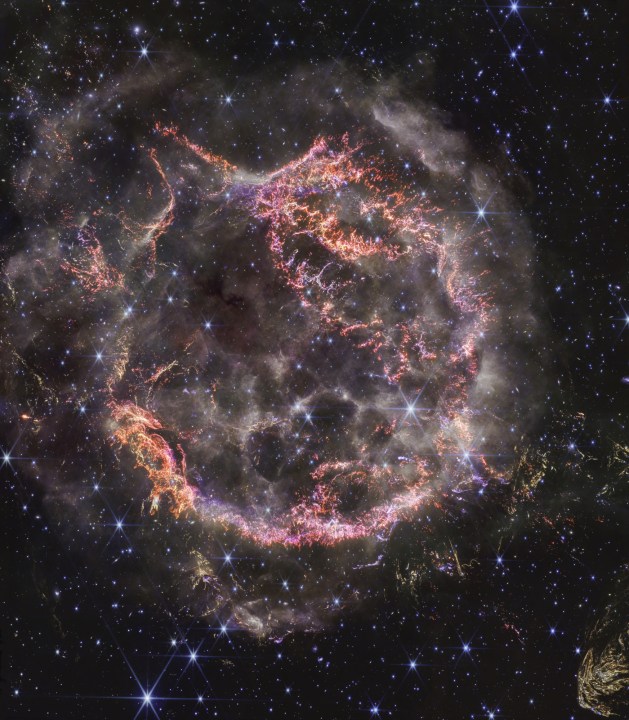
The end of a star’s life can involve a dramatic explosion, but that needn’t be entirely destructive. Such events can also create beautiful remnants, like this one, Cassiopeia A. Taken with the James Webb Space Telescope’s NIRCam instrument, it shows the shell of dust and gas thrown off by the star, which is traveling out into space and interacting with other material to form this beautiful structure.
Auroras over Earth
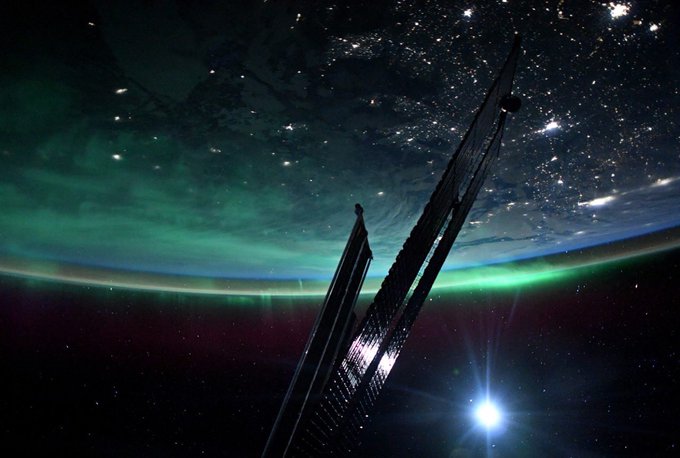
Some of the most stunning images of our planet are taken from space, like this image snapped by an astronaut on board the International Space Station in 2023. Josh Cassada took the image, which he described as “absolutely unreal” and which shows not only the lights of planet Earth below but also glowing auroras around the planet. These auroras are created by radiation from the sun interacts with the atmosphere, creating dazzling light displays. This was a particularly active period for the sun when it was sending out strong solar flares, causing the increased auroras.
Seeing the invisible
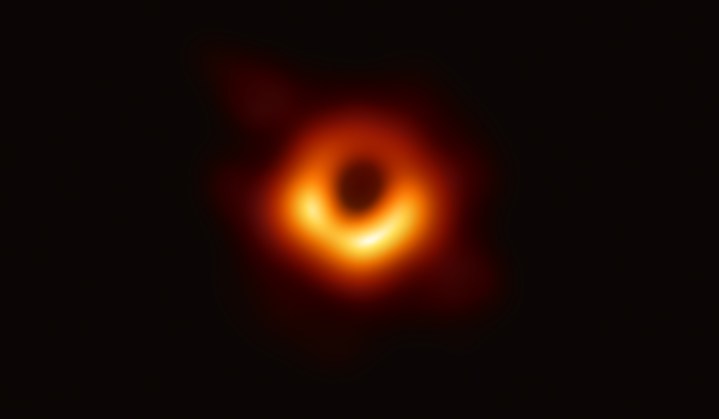
This image might not look like much, but in fact it is one of science’s greatest achievements of the 21st century. It is the first ever image taken of a black hole, which required an international collaboration of hundreds of scientists called the Event Horizon Telescope project. Black holes are so dense that their gravity sucks in anything that gets to close to them, even light. That makes them effectively invisible. However, at the edge of the black hole, called the event horizon, there can be a large amount of very hot gas which is heated by friction. The collaboration was able to view this hot gas using radio telescopes, to take this first image of a huge black hole located in the galaxy Messier 87. It is 55 million light-years away, and was a mass 6.5 billion times that of the sun.
Humans on the moon
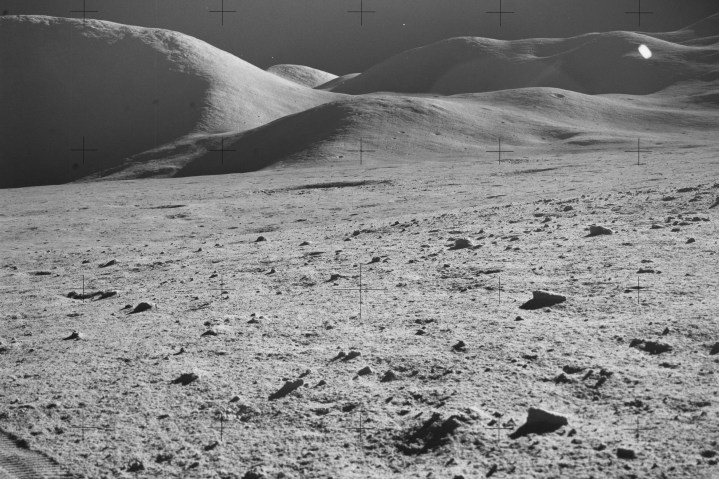
Even after more than 50 years, images from the Apollo missions still hold incredible power. This image was taken during Apollo 15, in 1971, and shows a region of the moon near Mount Hadley, located on the left of the image. During this mission astronauts David R. Scott and James B. Irwin explored the moon’s surface while Alfred M. Worden remained in orbit. The two astronauts on the surface were able to use a lunar rover to travel away from the landing site to look around the local area, the tracks of which are just visible in the bottom left of the image. The pair staying on the moon for a total of 67 hours, collecting rock and soil samples which are still studied to this day.
The entire Milky Way
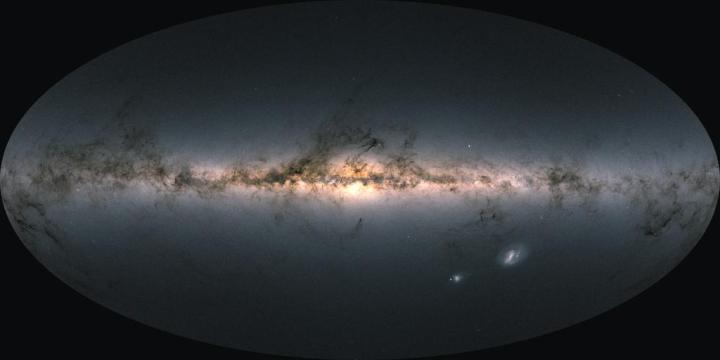
It’s not often that you get to see the entire galaxy at once. But that is what this image shows, bringing together a huge amount of data from the European Space Agency’s Gaia mission to show the entire Milky Way. Gaia is completing a galactic census, taking a survey of the entire galaxy to look for data on stars and other bodies. Currently it has observed approximately 1.8 billion bodies, and has collected data on the movements of 1.5 billion of them.
Editors' Recommendations
- The 5 best telescopes for beginners in 2024
- NASA is looking for ideas on how to boost the Hubble Space Telescope
- SpaceX eyes mission to extend life of NASA’s Hubble Space Telescope
- NASA’s private Ax-1 crew gets some extra time in space
- These amazing Earth photos from the ISS look more like works of art




